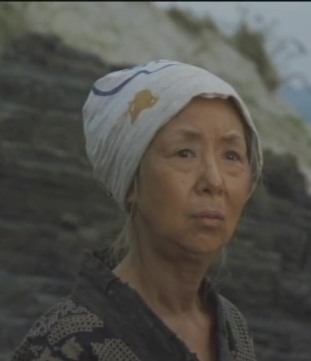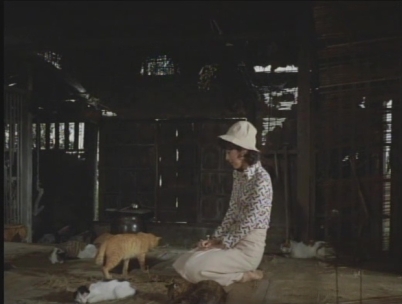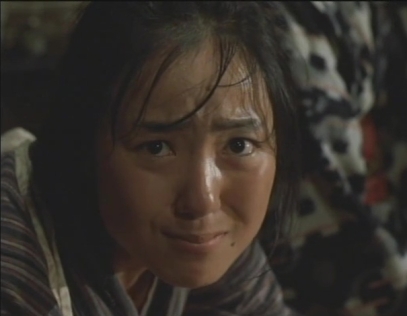
Kinuyo Tanaka as Osaki
Sandakan was the British name for a port town in northern Borneo, and Sandakan #8 was the eighth brothel on the main street. Most of the brothels were stocked with Japanese women. During the Meiji era, similar brothels spread all across Southeast Asia, and even into Manchuria and Siberia decades ahead of the Japanese military. A developing Japan short of its own physical resources encouraged the one export of which they had plenty – poor women – who for various reasons were much prized by European colonizers, Chinese traders, and the various locals. After WWI, however, as Japan tried to appear more completely westernized, these karayuki-san were in effect disowned by a society that had suddenly become embarrassed by their existence. Quite why this happened is inexplicable, since the practice of selling young girls into prostitution at home continued at least into the 1950s, and the government itself bought large numbers of “comfort women” in the 30s and 40s for work in areas occupied by Japanese troops. Nevertheless, it did happen, and the karayuki-san women became a set of outcasts that the whole country tried to forget had ever existed.
In 1972, Tomoko Yamazaki published a novel based on the memories of one of these women who had eventually returned to Japan, which Kei Kumei in his quiet and humane manner adapted into the extremely successful film Sandakan 8, and in 1975 Imamura made a documentary that covered much the same ground in much the same way using on-camera interviews with a survivor who had stayed in Malaysia.
A writer comes to Amakusa, one of the more remote islands of Japan, a known home for many of the karayuki-san, but no one will help her with her research. In a small diner, she offers a cigarette to Osaki, a woman who is breaking apart the leavings in an ashtray to take home with her, and compliments her on her clear accent. The woman says she learned it “abroad,” then is so shocked at her own admission, she runs away. She leaves her pipe, and the writer follows her to return it. Osaki is the local cat lady, living in a hovel with holes in the wood and paper walls, and introduces the stranger to her neighbors as her daughter-in-law.

Waiting for tea with the cats in Osaki’s house
The writer returns some time later and, arriving in a rain storm, asks to stay overnight. Gradually, this turns into three weeks, during which Osaki begins to tell her story, which we see in flashbacks. It is a story we have seen dozens of times in Japanese movies, the only difference being that she is sold to a man who takes her overseas. The family is left fatherless, the mother remarries, the girl offers to be sold so her brother can start saving money to buy back the farm. First she is a maid but eventually is forced to become a prostitute in a first night that is a rape. She hates the work, but decides to work hard to make enough money to pay off her debt and send money home. Some of the women will take only white men or Japanese, but Osaki decides to take everyone in order to make more money and even learns the local dialect. She falls in love with a Japanese worker on a rubber plantation, even paying for his nights with her, but he deserts her after he finds her exhausted from a night when the brothels were overrun by Japanese sailors who have just docked in the harbor. The boss dies and the new owner tries to sell her to a Cambodian brothel, but she is saved by the kindliest of the other owners, a woman who has paid for a graveyard for the karayuki-san who die there. When the woman dies, she leaves her girls enough money to return to Japan, where Osaki finds herself an outcast in her own village, thrown out of the house by her sister-in-law despite having paid for the house with the money she sent back. She goes to Manchuria where she gets married and has a son, but the family loses everything after the war and the son’s eventual wife throws her out again, so she returns to her original home where she barely survives as an outcast on the 400 yen each month that her son sends her.
The boss dies and the new owner tries to sell her to a Cambodian brothel, but she is saved by the kindliest of the other owners, a woman who has paid for a graveyard for the karayuki-san who die there. When the woman dies, she leaves her girls enough money to return to Japan, where Osaki finds herself an outcast in her own village, thrown out of the house by her sister-in-law despite having paid for the house with the money she sent back. She goes to Manchuria where she gets married and has a son, but the family loses everything after the war and the son’s eventual wife throws her out again, so she returns to her original home where she barely survives as an outcast on the 400 yen each month that her son sends her.
As I say, we’ve seen all this in movies before, except for the overseas aspect, but never all at once. And rarely have we seen it with an actress who looks so young as Yoko Takahashi, who really does manage to look less than 14 when she begins her trade and younger than the girl at the end of Mizoguchi’s Street of Shame.

Yoko Takahashi
The elderly Osaki is Kinuyo Tanaka, returning to a large role for the first time in more than a decade and reminding us how much we have missed her. (Interestingly, one of her last major roles was in Kinoshita’s Legend, another movie about the Japanese desire to sweep away all uncomfortable parts of the past.)
The story is framed by the writer’s trip to modern Sandakan looking for any verification of Osaki’s story. The brothel is gone, bombed by the allies in the war, and no witnesses are left because the Japanese troops slaughtered all the local inhabitants before retreating into the jungle. After much effort, however, she does locate the graveyard, now overgrown by jungle. The great shock is her discovery that all of the graves face south, purposely turning their backs on Japan just as Japan had turned its back on them.
One fascinating aspect of Osaki’s relationship with the writer is the insistence that she play the daughter-in-law. Osaki appreciates her son’s money, without which she would starve, but she is much more depressed that the daughter-in-law not only never visits but has never even written, so that the daughter-in-law seems far more important to Osaki than her son.
Kumei plays no tricks with his story-telling. He is examining yet another of Japan’s outcast groups, lest they be forgotten completely, but without preachiness or anger or camera gimmicks. The movie is told so straight-forwardly it managed to win an Oscar for Best Foreign Film.* If you have not seen many Japanese movies of the earlier decades, Osaki’s story will shock and outrage you, but if you have seen many of the others involving young girls sold into brothels, it will seem a quiet, extremely well-made, but familiar story.
* Most of Kumai’s movies were independently produced, often in 4×3 like ATG movies but distributed by major studios. IMDB says this was shot in wide screen, but as the screen captures indicate, Criterion’s version is also in 4×3, and it is hard to imagine Criterion releasing a pan & scan version of anything.
Pingback: An Adolescent / Shojo/ Shoujyo (2001) | Japanonfilm
Pingback: Shinsetsu* (1942) | Japanonfilm
Pingback: The Sea is Watching / Umi wa miteita (2002) | Japanonfilm